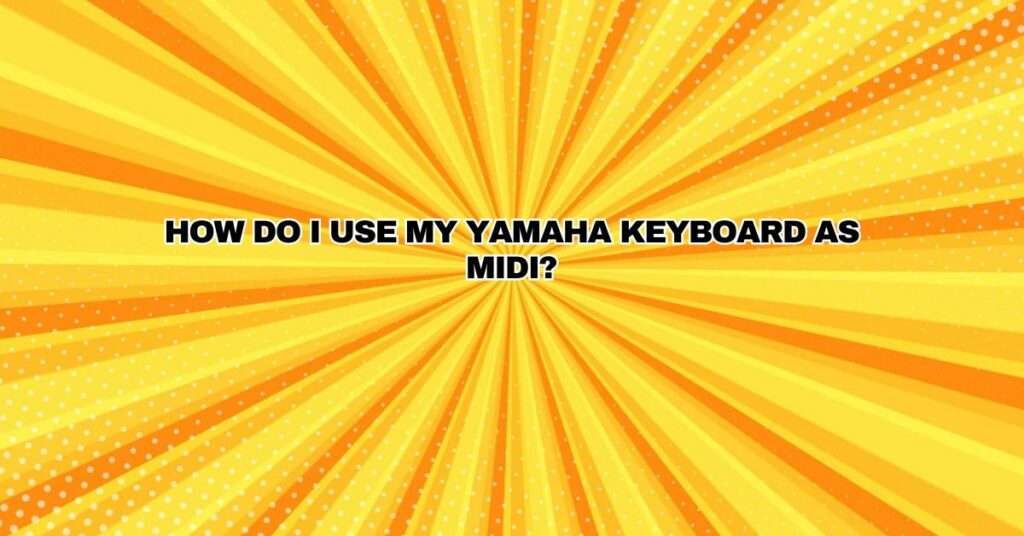Yamaha keyboards are known for their versatility and excellent sound quality, making them popular choices for both beginners and professional musicians. One of the many features Yamaha keyboards offer is the ability to use them as MIDI controllers. This allows you to connect your keyboard to a computer or other MIDI-compatible devices and use it to trigger virtual instruments, record music, and control various parameters in your digital audio workstation (DAW). In this comprehensive guide, we’ll walk you through the steps to set up and use your Yamaha keyboard as a MIDI controller.
Prerequisites:
Before you start, make sure you have the following:
- Yamaha Keyboard: Ensure that your Yamaha keyboard is equipped with MIDI capabilities. Most modern Yamaha keyboards have USB-MIDI, making the connection process more straightforward.
- Computer: You’ll need a computer (Windows or Mac) to connect to your Yamaha keyboard.
- USB Cable: If your Yamaha keyboard has a USB-MIDI interface, you’ll need a USB Type A to Type B cable (commonly used for printers). If your keyboard uses standard MIDI ports, you’ll need a MIDI-to-USB interface.
- Digital Audio Workstation (DAW): To fully utilize your keyboard as a MIDI controller, you’ll need a DAW such as Ableton Live, Logic Pro, Pro Tools, Cubase, or a free DAW like Audacity or Cakewalk.
Using Your Yamaha Keyboard as a MIDI Controller:
Follow these steps to set up and use your Yamaha keyboard as a MIDI controller:
For Keyboards with USB-MIDI:
- Power Off the Keyboard: Ensure your Yamaha keyboard is powered off.
- Connect the USB Cable: Plug one end of the USB cable (Type A) into an available USB port on your computer.
- Connect the Other End: Plug the other end of the USB cable (Type B) into the USB-MIDI port on your Yamaha keyboard.
- Power On the Keyboard: Turn on your Yamaha keyboard.
- Install Necessary Drivers (if required – Windows): If you’re using a Windows PC, your operating system may automatically recognize the keyboard and install the necessary drivers. If not, visit the official Yamaha website to download and install the drivers specific to your keyboard model.
- Install Necessary Drivers (Mac): On a Mac, you usually don’t need additional drivers for basic MIDI functionality. The keyboard should be recognized by macOS.
- Open Your DAW: Launch your DAW (e.g., Ableton Live, Logic Pro).
- Create a MIDI Track: In your DAW, create a new MIDI track.
- Select Your Yamaha Keyboard: Set the MIDI input of the track to your Yamaha keyboard. It should appear as an available input device in your DAW’s MIDI settings.
- Load Virtual Instruments: In your DAW, load a virtual instrument (VSTi) or software instrument. When you play your Yamaha keyboard, the MIDI signals will trigger the sounds from the virtual instrument.
- Play and Record: Now, you can play your Yamaha keyboard to trigger the virtual instrument’s sounds. You can also record your performance in your DAW.
For Keyboards with Standard MIDI Ports:
- Power Off the Keyboard: Make sure your Yamaha keyboard is powered off.
- Connect the MIDI-to-USB Interface: Plug one end of the MIDI-to-USB interface into the MIDI out port on your Yamaha keyboard. Connect the other end to an available USB port on your computer.
- Power On the Keyboard: Turn on your Yamaha keyboard.
- Install Necessary Drivers (if required – Windows): If you’re using Windows, you may need to install drivers for your MIDI-to-USB interface. Visit the manufacturer’s website to download and install the required drivers.
- Install Necessary Drivers (Mac): Mac users typically do not need additional drivers for basic MIDI functionality.
- Open Your DAW: Launch your DAW (e.g., Ableton Live, Logic Pro).
- Create a MIDI Track: In your DAW, create a new MIDI track.
- Select Your Yamaha Keyboard: Set the MIDI input of the track to your MIDI-to-USB interface or the Yamaha keyboard if it’s recognized directly.
- Load Virtual Instruments: Load a virtual instrument (VSTi) or software instrument in your DAW. When you play your Yamaha keyboard, the MIDI signals will trigger the sounds from the virtual instrument.
- Play and Record: Now you can play your Yamaha keyboard to trigger the virtual instrument’s sounds, and you can also record your performance in your DAW.
Tips for a Productive Experience:
- Learn MIDI Basics: Understanding MIDI concepts like channels, notes, and controllers will help you make the most of your Yamaha keyboard’s capabilities in your DAW.
- Experiment with Virtual Instruments: Your DAW likely includes a wide variety of virtual instruments. Experiment with different sounds and instruments to enhance your music.
- Record and Edit: Once connected, you can record your keyboard performances, edit them, and add effects or other tracks to create complete compositions.
- Regularly Update Software: Keeping your DAW and computer’s operating system up to date ensures the best performance and compatibility.
In conclusion, using your Yamaha keyboard as a MIDI controller is a powerful and versatile way to create, record, and produce music. Whether you’re a novice musician or an experienced producer, this setup can take your music to new heights. By understanding MIDI basics and exploring the vast world of virtual instruments, you can unlock your keyboard’s full potential and enjoy a rich and creative musical journey.


